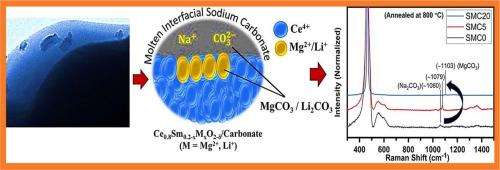“在固体氧化物燃料电池的混合氧化铈/碳酸盐界面上导航杂质阻碍电负性界面碳酸盐。”
IF 6.3
2区 材料科学
Q2 CHEMISTRY, PHYSICAL
引用次数: 0
摘要
近年来,铈-碳酸盐复合电解质在低温固体氧化物燃料电池(LT-SOFCs)中的应用备受关注。碳酸盐在复合电解质中的主要优点是它在电导率增强方面的作用,这是通过几种不同的机制提出的。本研究将碳酸盐电负性界面对杂质侵入铈晶格所造成的阻碍进行了研究,并注意到一些有趣的事实。系统地检查了在晶界区域加入碳酸盐的系统退火的掺杂二氧化铈的结构-性能关系,揭示了碳酸盐性质的变化,特别是在600 -800°C之间退火时。由于碳酸盐和基体铈之间的电负性差异,添加的杂质(镁和锂)与界面碳酸盐表现出优先键合,这可以从拉曼光谱中碳酸盐峰位置的变化中得到证明。拉曼光谱的定量分析表明,在600°C退火时,样品的缺陷浓度增加,当退火温度提高到800°C时,缺陷浓度意外下降,这进一步支持了这一点。电化学阻抗谱(EIS)表明,碳酸盐存在时活化能降低,导致电解质电阻降低,从而导致界面导电性增强。通过在较高温度(1200℃)下退火制备的样品,使界面碳酸盐挥发,导致第二阶段杂质,特别是锂,在铈相中掺入。所选的高温退火样品的燃料电池性能显示出令人印象深刻的结果,并且在材料证明具有长期稳定性的情况下适合燃料电池应用。因此,由于含碳酸盐电解质在烧结后可能存在残余孔隙,影响其气密性和长期稳定性,因此需要进行具有微观结构表征的长期稳定性研究。本文章由计算机程序翻译,如有差异,请以英文原文为准。

"Navigating the impurity-obstructive electronegative interfacial carbonate on the hybrid ceria/carbonate interface for solid oxide fuel cells."
Ceria-carbonate composite electrolytes have received much attention in recent years for application in low-temperature solid oxide fuel cells (LT-SOFCs). The principal advantage of carbonate in composite electrolytes is its role in conductivity enhancement, proposed through several different mechanisms. This study navigates the scarcely studied obstruction caused by electronegative interfacial carbonate to impurity intrusion into the ceria lattice, with some interesting facts being noted. The methodically examined structure-property relationship of systematically annealed doped ceria, incorporated with carbonate at the grain boundary region, revealed a change in the nature of carbonate especially when annealed between 600 –800 °C. Owing to the electronegativity difference between carbonate and host ceria, the added impurities (magnesium and lithium) showed preferential bonding with the interfacial carbonate evidenced by a change in peak positions for carbonate in the Raman spectra. This was further supported by an increase in defect concentration for samples that were annealed at 600 °C, which unexpectedly declined when the annealing temperature was increased to 800 °C, as demonstrated by the quantitative analysis of Raman spectra. Electrochemical impedance spectroscopy (EIS) indicated lower activation energy in the presence of carbonate, leading to reduced electrolyte resistance, thereby resulting in enhanced interfacial conductivity. Volatilizing the interfacial carbonate by annealing the prepared samples at higher temperatures (1200 °C) resulted in a second-stage incorporation of impurities, especially lithium, in the ceria phase. The fuel cell performance of selected high-temperature annealed samples showed impressive results and suitability for fuel cell applications provided the materials prove to display long-term stability. Therefore, long-term stability studies with microstructural characterization would be needed as the carbonate-containing electrolytes may show residual porosity after sintering, which could affect gas-tightness and long-term stability.
求助全文
通过发布文献求助,成功后即可免费获取论文全文。
去求助
来源期刊

Surfaces and Interfaces
Chemistry-General Chemistry
CiteScore
8.50
自引率
6.50%
发文量
753
审稿时长
35 days
期刊介绍:
The aim of the journal is to provide a respectful outlet for ''sound science'' papers in all research areas on surfaces and interfaces. We define sound science papers as papers that describe new and well-executed research, but that do not necessarily provide brand new insights or are merely a description of research results.
Surfaces and Interfaces publishes research papers in all fields of surface science which may not always find the right home on first submission to our Elsevier sister journals (Applied Surface, Surface and Coatings Technology, Thin Solid Films)
 求助内容:
求助内容: 应助结果提醒方式:
应助结果提醒方式:


